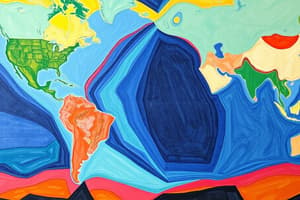Podcast
Questions and Answers
What is the primary force driving plate motion in the theory of plate tectonics?
What is the primary force driving plate motion in the theory of plate tectonics?
- Convection currents in the Earth's crust
- Convection currents in the Earth's mantle (correct)
- Tidal forces
- Wind and ocean currents
What is the process by which new oceanic crust is created at mid-ocean ridges?
What is the process by which new oceanic crust is created at mid-ocean ridges?
- Seafloor compression
- Seafloor tension
- Seafloor spreading (correct)
- Seafloor erosion
What is the term for the reversal of the Earth's magnetic field over time?
What is the term for the reversal of the Earth's magnetic field over time?
- Magnetic reversal (correct)
- Magnetic fluctuations
- Magnetic polarity
- Magnetic anomalies
What type of plate boundary is characterized by two plates moving away from each other?
What type of plate boundary is characterized by two plates moving away from each other?
What is the primary mechanism for creating new oceanic crust?
What is the primary mechanism for creating new oceanic crust?
What is responsible for the distribution of earthquakes and volcanoes?
What is responsible for the distribution of earthquakes and volcanoes?
How many major plates are there in the theory of plate tectonics?
How many major plates are there in the theory of plate tectonics?
What is the term for the process of one plate being forced beneath another?
What is the term for the process of one plate being forced beneath another?
Flashcards are hidden until you start studying
Study Notes
Plate Tectonics
- The theory that the Earth's lithosphere is divided into large plates that move relative to each other
- Plates can be in motion due to convection currents in the Earth's mantle
- There are 7 major plates and several smaller ones
Seafloor Spreading
- The process of new oceanic crust being created at mid-ocean ridges
- Magma rises from the Earth's mantle to the surface, solidifying into new crust
- As new crust is created, older crust is pushed away from the ridge, resulting in the seafloor moving away from the ridge
Evidence for Seafloor Spreading
- Magnetic Reversals: rocks on either side of a mid-ocean ridge show alternating magnetic polarities, indicating that the Earth's magnetic field has reversed over time
- Age of Rocks: rocks closest to the ridge are younger, while those further away are older, indicating that the seafloor is moving away from the ridge
- Mid-Ocean Ridge Topography: the ridge is characterized by a central rift valley, with symmetrical topography on either side
Types of Plate Boundaries
- Divergent: where two plates are moving away from each other, resulting in seafloor spreading (e.g. mid-ocean ridges)
- Convergent: where two plates are moving towards each other, resulting in subduction or collision
- Transform: where two plates are sliding past each other horizontally, without creating or destroying crust
Importance of Plate Tectonics and Seafloor Spreading
- Earthquakes and Volcanoes: plate movement is responsible for the distribution of earthquakes and volcanoes
- Creation of Oceanic Crust: seafloor spreading is the primary mechanism for creating new oceanic crust
- Shaping of the Earth's Surface: plate tectonics has played a crucial role in shaping the Earth's surface over billions of years
Plate Tectonics
- The Earth's lithosphere is broken into large plates, ranging from 7 major plates to several smaller ones, that move relative to each other.
- Convection currents in the Earth's mantle are the driving force behind plate motion.
Seafloor Spreading
- Mid-ocean ridges are the birthplace of new oceanic crust, created through the upwelling of magma from the Earth's mantle.
- As new crust forms, older crust is pushed away from the ridge, resulting in the seafloor moving away from the ridge.
- This process is continuous, with the seafloor constantly moving away from the mid-ocean ridges.
Evidence for Seafloor Spreading
- Magnetic Reversals: rocks on either side of a mid-ocean ridge exhibit alternating magnetic polarities, indicating the Earth's magnetic field has reversed over time.
- Age of Rocks: the age of rocks increases with distance from the ridge, with the youngest rocks closest to the ridge.
- Mid-Ocean Ridge Topography: the central rift valley and symmetrical topography on either side of the ridge are characteristic features.
Types of Plate Boundaries
- Divergent Boundaries: plates moving away from each other, resulting in seafloor spreading, e.g., mid-ocean ridges.
- Convergent Boundaries: plates moving towards each other, resulting in subduction or collision.
- Transform Boundaries: plates sliding past each other horizontally, without creating or destroying crust.
Importance of Plate Tectonics and Seafloor Spreading
- Earthquakes and Volcanoes: plate movement is responsible for the distribution of earthquakes and volcanoes on the Earth's surface.
- Creation of Oceanic Crust: seafloor spreading is the primary mechanism for creating new oceanic crust.
- Shaping of the Earth's Surface: plate tectonics has played a crucial role in shaping the Earth's surface over billions of years, resulting in the formation of mountains, volcanoes, and ocean basins.
Studying That Suits You
Use AI to generate personalized quizzes and flashcards to suit your learning preferences.




